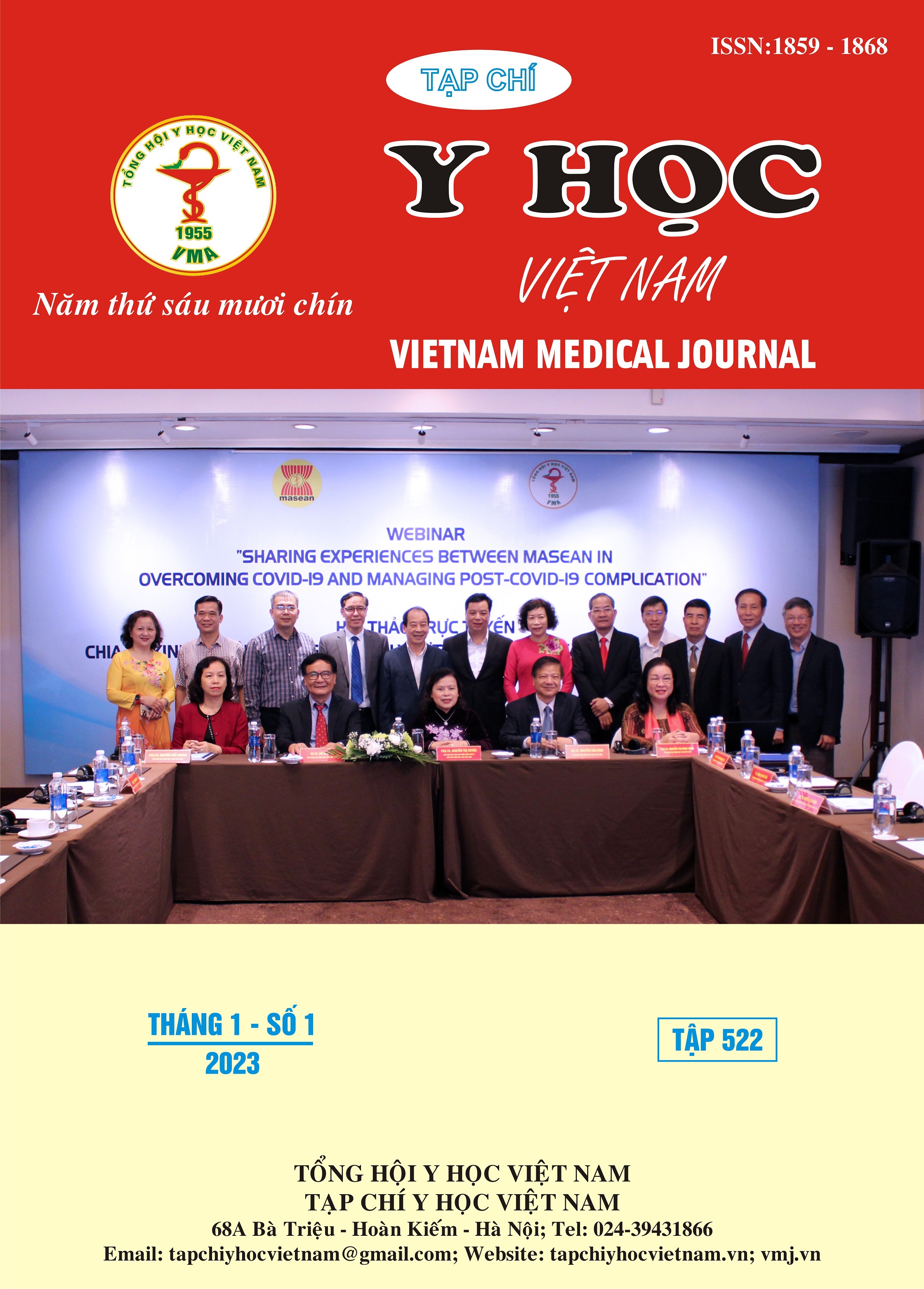IGE ĐẶC HIỆU VỚI 52 DỊ NGUYÊN VÀ MỐI LIÊN QUAN VỚI MỘT SỐ ĐẶC ĐIỂM LÂM SÀNG, CẬN LÂM SÀNG TRÊN BỆNH NHÂN MÀY ĐAY MẠN TÍNH
Nội dung chính của bài viết
Tóm tắt
Mục tiêu: Mô tả kết quả và khảo sát mối liên quan của Immunoglobin E (IgE) đặc hiệu với 52 dị nguyên (allergen-specific IgE - sIgE) và mối liên quan với một số đặc điểm lâm sàng cận lâm sàng bệnh nhân mày đay mạn tính. Đối tượng và phương pháp nghiên cứu: Đối tượng: 265 bệnh nhân được chẩn đoán mày đay mạn tính từ 08/2021 đến 08/2022 tại bệnh viện Da liễu Trung Ương được chỉ định làm xét nghiệm test 52 dị nguyên đáp ứng tiêu chuẩn lựa chọn và loại trừ. Phương pháp nghiên cứu: mô tả cắt ngang. Kết quả: Trong số 265 bệnh nhân: nhóm dị nguyên môi trường có tỉ lệ sIgE dương tính mức độ cao nhất và mạnh nhất trong đó: bụi farina dương tính rất mạnh 1,5%; bụi Pter dương tính rất mạnh 0,4%; lông mèo dương tính rất mạnh 0,4% bụi Blomia dương tính mạnh 1,5%; cỏ bemuda dương tính mạnh 0,4%. Tiếp theo là nhóm dị nguyên côn trùng: nọc ong bắp cày dương tính rất mạnh 2,3%; kiến lửa dương tính mạnh 0,4%; gián dương tính mạnh 0,4%. Nhóm dị nguyên protein: lòng trắng trứng có tỉ lệ sIgE dương tính mức độ cao nhất và mạnh nhất là: dương tính mạnh 0,4%, tiếp đến tôm dương tính là 0,4%. Tỉ lệ sIgE thịt bò dương tính rất thấp 3,8%. Nhóm dị nguyên carbonhydrate: hạt hạnh nhân có tỉ lệ sIgE dương tính mức độ cao nhất và mạnh nhất là dương tính 0,4%. 100% bệnh nhân có test dị nguyên bột mỳ, bột lúa mạch đen, bột lúa mạch và bột yến mạch mức độ âm tính và dương tính rất thấp/dương tính thấp. Dị nguyên men bia gây 0,4% bệnh nhân dương tính rất mạnh. Đa số bệnh nhân âm tính với dị nguyên sữa, quả, chỉ có 0,4% bệnh nhân dương tính rất mạnh với dứa; 0,4% dương tính với cam; 0,4% dương tính thấp với Alpha lactalbumin và 0,4% bệnh nhân dương tính thấp với Betaglobulin. Hầu hết người bệnh cho kết quả xét nghiệm âm tính với dị nguyên nấm. Kết quả từ mô hình hồi quy logistic cho thấy tuổi khởi phát mày đay < 18 tuổi, ngứa hàng ngày, thời gian tồn tại ban da trên 12 giờ, thời gian bị bệnh dưới 1 năm, IgE toàn phần > 100KU/l và tiền sử dị ứng là những yếu tố tiên lượng độc lập dự đoán dương tính đối với test 52 dị nguyên của bệnh nhân nghiên cứu. Kết luận: Test 52 dị nguyên là chỉ định có giá trị chẩn đoán nguyên nhân bệnh nhân mày đay mạn tính có tiền sử dị ứng, tuổi khởi phát mày đay dưới 18 tuổi, thời gian bị bệnh dưới 1 năm hoặc có IgE toàn phần > 100kU/l
Chi tiết bài viết
Từ khóa
test 52 dị nguyên, IgE đặc hiệu dị nguyên, mày đay mạn tính
Tài liệu tham khảo
2. Asero R, Tedeschi A, Marzano AV, Cugno M. Chronic urticaria: a focus on pathogenesis. F1000Research. 2017;6. doi:10.12688/ f1000research.11546.1
3. Zuberbier T, Aberer W, Asero R, et al. The EAACI/GA2LEN/EDF/WAO guideline for the definition, classification, diagnosis, and management of urticaria. Allergy. 2018;73(7):1393-1414. doi:10.1111/all.13397
4. Johansson SGO. The History of IgE: From Discovery to 2010. Curr Allergy Asthma Rep. 2011;11(2):173-177. doi:10.1007/s11882-010-0174-3
5. Chang KL, Yang YH, Yu HH, Lee JH, Wang LC, Chiang BL. Analysis of serum total IgE, specific IgE, and eosinophils in children with acute and chronic urticaria. J Microbiol Immunol Infect Wei Mian Yu Gan Ran Za Zhi. 2013;46(1):53-58. doi:10.1016/j.jmii.2011.12.030
6. Võ DNS, Võ DT, Lương QT, Nguyễn THV, Phạm TVP. Phân tích mức độ kháng thể IgE trong huyết thanh của bệnh nhân mày đay cấp tính và mạn tính tại Bệnh viện Da liễu thành phố Đà Nẵng năm 2021. Tạp Chí Khoa Học Đại Học Đông Á. 2022;1(02):14-29.
7. Phạm Đình Lâm*, VTT. Kháng thể IgE đặc hiệu và xét nghiệm lẩy da trên bệnh nhân mày đay. Accessed October 9, 2022. https://yhoctphcm.ump.edu.vn/index.php?Content=ChiTietBai&idBai=15044
8. Zeng YH, Zhang D, Shu Y, et al. [Detection of serum specific IgE in 437 children with the allergic disease]. Zhongguo Dang Dai Er Ke Za Zhi Chin J Contemp Pediatr. 2009;11(7):543-545.


